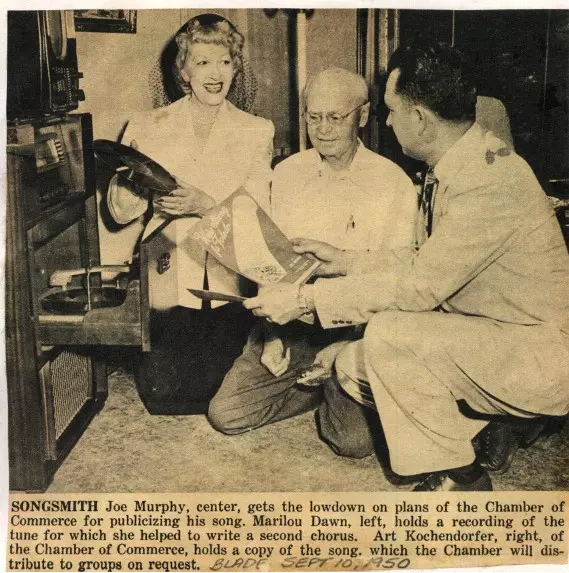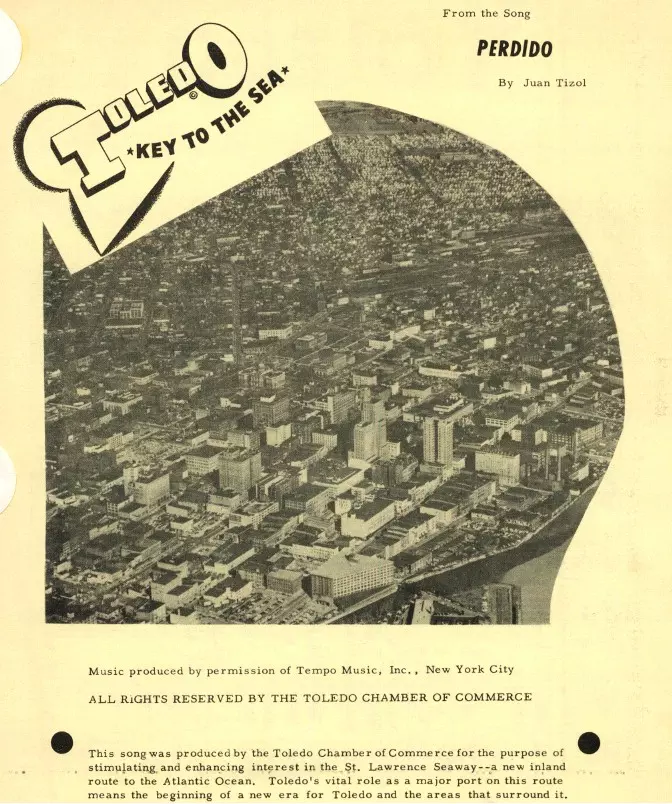Postwar Hopes
It wasn’t until the mid-1940s and the militarization of the economy during World War Two that Toledo’s employment rolls, wages, or population began to recover. Many feared that the wartime recover would prove to be just that, a feature of war and not the peace that would follow. But by the early 1950s, Toledo’s economy was growing again and the old songs of boosterism were taken off the shelf, dusted off, and put to work again.
In 1950, the Chamber of Commerce took out a copyright on Joe Murphy’s old "We’re Strong for Toledo" song and began printing the score. Though the businessmen of Toledo were nostalgic for the locally famous tune, to the Chamber, Murphy’s lyrics were apparently not an adequate advertisement for the city. The Chamber had Marilou Dawn compose some added verses that spoke to an age of American business triumphant:
Building on its newfound interest in the musical arts, the Chamber of Commerce next commissioned a song to call attention to the opening of the St. Lawrence Seaway and Toledo’s place in the trade of the Great Lakes. For this duty the Chamber tapped Edmund Wheelden, Jr., member of the Chamber’s public relations department and a local factory president, who penned "Toledo, Our Future’s Terrific" set to a tune that Duke Ellington popularized, Perdido.
Though recordings were made of "Toledo, Our Future’s Terrific," by the El Myers Quintet, a local band, none seem to have survived the ravages of time.
The 1950s proved to be the rival of the 1920s in its song output. In 1957, just a year after the release of "Toledo, Our Future’s Terrific," Walter Schwartz, an employee of the City’s Harbor and Bridges department, revised the lyrics to "We’re Strong for Toledo" to give them a nautical twist. Gathering together a group of friends who had never sung together—Marvin Stimpfle, Carl Murphy, and George Yeats,—Schwartz recorded the song and dubbed his group the Channel Markers. Schwartz’s version was:
The Port SongWe’re strong for Toledo |
Listen to audio
Walter Schwartz, The Port Song, 1958. Music used with the permission of BMI Music |
Most notably about Schwartz’s Port Song, was his use of ambient sounds. The song begins with a blast from the horn of a passing freighter and continues with a faint sound of lapping waves beneath the chorus.
The capstone to this era of musical promotion came in 1965, when the Toledo Area Development Corporation commissioned "Let’s Expand Toledo’s Future." Set to the tune of "I’ve Been Working on the Railroad," this song stripped away all the distracting cant about seasons, trees, and loyal people to attain a purity of form seldom rivaled:
Let’s Expand Toledo’s FutureLet’s expand Toledo’s futureWith salesmanship today. Let’s expand Toledo’s future The T.A.D.C. way. The days of gloom are gone forever. Our town has been reborn. Can’t you hear our people shouting, Toledo, Blow your horn. Toledo won’t you blow, Toledo won’t you blow, Toledo won’t you blow your ho-o-orn! Toledo won’t you blow, Toledo won’t you blow, Toledo won’t you blow your horn. |
Someone’s in there pitchin’ Toledo.
|
This song’s final line, in its stark honesty, may never be rivaled within this category of expression. That the song did not last was not its own fault, but that of timing. Within a handful of years of its appearance, the industrial economy of the entire northeastern United States began to weaken and shift. Toledo sat astride the so-called "rust belt" and suffered a wave of plant closings, some of which, like that of Toledo Scale, seemed to steal away a piece of the city’s identity.



